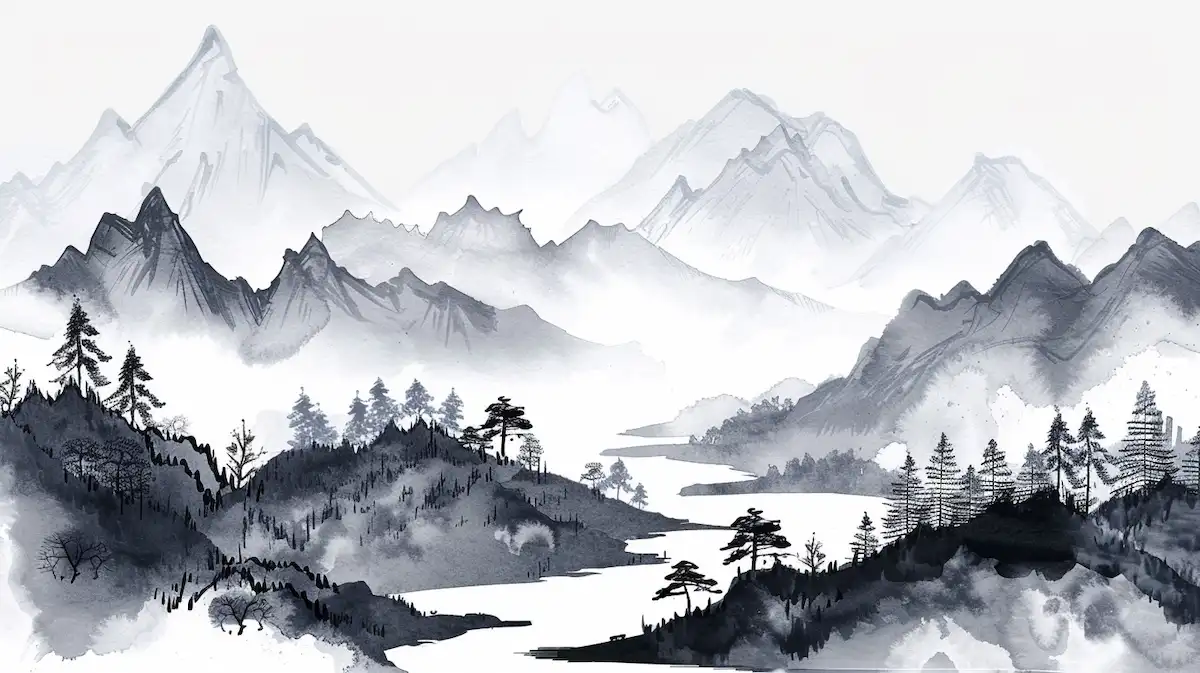水墨画を英語で説明・紹介するための基本情報と、英会話に役立つ表現をシンプルでわかりやすい英語で紹介します。
英会話ダイアローグ・関連情報・10の質問を通して、水墨画に関する英語表現を学びます。
英語
英会話ダイアローグを読む前に知っておくと良い前提知識と情報です。
- 水墨画の基本情報
- 水墨画は、墨を使って絵を描く絵画技法
- 墨の濃淡やにじみを活かして、自然の風景や人物を描く
- シンプルでありながら、深い感情や美しさを表現することが特徴
- 歴史的背景
- 水墨画は中国の唐代(618-907年)に始まり、宋代(960-1279年)に大きく発展
- 日本には鎌倉時代後期(1185-1333年)から室町時代(1336-1573年)にかけて伝わり、禅宗とともに広まった
- 代表的な画家
- 如拙:代表作「瓢鮎図(ひょうねんず)」
- 雪舟等楊:水墨画を大成、「秋冬山水図」や「破墨山水図」などが有名
- 精神的側面
- 水墨画は禅の哲学と深く結びつき、心の静けさや自然の美しさを描くことを重視
- 描く過程自体が瞑想的な行為
2人が「水墨画」について話しています。
水墨画の起源や技法、自然との関わり、水墨画を大成した雪舟と彼の作品やエピソードなどを話題にしています。
会話 / dialogue

Hey Key, I’ve been really interested in ink wash painting lately. Do you know much about it?

Yeah, I do. Ink wash painting, or sumi-e, is a traditional East Asian art form that uses black ink to create beautiful images.

Interesting. When did it start?

It started in China during the Tang Dynasty and became really popular in Japan from the late Kamakura period through the Muromachi period.

That’s fascinating. What makes ink wash painting so special?

One of the amazing things about it is its emotional depth. Artists use just black ink to capture deep emotions and moods.

How does it connect to nature?

It’s closely linked to nature and Zen philosophy. The simplicity of the ink wash technique brings out the essence of nature and reflects a sense of tranquility.

I’ve heard about some famous ink wash artists. Can you tell me more about them?

Sure. One of the important early Japanese artists is Josetsu. He created the famous painting “Catching a Catfish with a Gourd”.

What about Sesshū Tōyō?

Sesshū Tōyō is one of the greatest artists who perfected ink wash painting in Japan. He traveled to China to study and brought back advanced techniques.

What are some of his famous works?

His works, like “Autumn and Winter Landscapes” and “Splashed Ink Landscape”, are masterpieces.

Sesshū sounds incredible. Any interesting stories about him?

Yes, there’s a famous story from his childhood. He was so passionate about drawing that once, when he was punished and tied to a pillar, he used his tears to draw a mouse on the floor.

Really? What happened then?

His teacher saw it and was amazed by his talent. Later, Sesshū went to China to learn more and brought back new techniques that he used to create his unique style. He really perfected ink wash painting in Japan.

So he had a big impact on ink wash painting?

Absolutely. He made a huge impact on the art form, and his work is still highly regarded today.

What do you think makes ink wash painting so attractive to people?

Its beauty lies in its simplicity and elegance. The contrast between the black ink and white paper is striking.

And the use of empty space, right?

Yes, the use of empty space, or “ma”, is crucial in creating a balanced and harmonious composition.

Thanks for sharing all this, Key. I’m even more interested in ink wash painting now.
関連情報 / related information
「水墨画」について、理解を深めるための「英語での関連情報」です。
水墨画

What is Ink Wash Painting?
Ink wash painting, also known as sumi-e, is a traditional East Asian art form that uses black ink to create beautiful images. Artists use different shades of black to depict nature, landscapes, and figures. The technique emphasizes simplicity, capturing the essence of the subject with minimal brush strokes.
Historical Background
Ink wash painting began in China during the Tang Dynasty (618-907 AD). It developed further in the Song Dynasty (960-1279 AD). Japanese Zen monks brought the technique to Japan in the late Kamakura period (1185-1333 AD). The art form became very popular in Japan during the Muromachi period (1336-1573 AD), blending with Japanese culture and Zen philosophy.
Famous Artists
Some of the most famous artists in ink wash painting include Josetsu and Sesshū Tōyō. Josetsu is known for his work “Catching a Catfish with a Gourd”. Sesshū Tōyō perfected the art in Japan, creating masterpieces like “Autumn and Winter Landscapes” and “Splashed Ink Landscape”. His travels to China helped him bring back advanced techniques to Japan.
Techniques and Expression
Ink wash painting uses various brush techniques, such as straight brush (chokuhitsu) for fine lines and side brush (sokuhitsu) for broader strokes. Artists control the thickness of the ink and the pressure on the brush to create different effects. This allows them to express deep emotions and the beauty of nature with simple black ink.
Spiritual Aspect
Ink wash painting is deeply connected to Zen Buddhism. It emphasizes mindfulness, simplicity, and the beauty of nature. The process of painting is meditative, helping the artist to focus and reflect. This spiritual aspect adds a deeper meaning to the art, making it not just a visual experience but a philosophical one as well.
10の質問 / 10 questions
「水墨画」について、理解を深めるための「英語での10の質問」です。
1.What is ink wash painting?
Ink wash painting, also known as sumi-e, is a traditional East Asian art form that uses black ink to create images. It emphasizes simplicity and captures the essence of the subject with minimal brush strokes.
2.When did ink wash painting start?
Ink wash painting began in China during the Tang Dynasty (618-907 AD) and became popular in Japan from the late Kamakura period through the Muromachi period.
3.Who are some famous ink wash painters?
Famous ink wash painters include Josetsu, known for “Catching a Catfish with a Gourd,” and Sesshū Tōyō, who perfected the art in Japan with works like “Autumn and Winter Landscapes” and “Splashed Ink Landscape.”
4.What are the basic tools for ink wash painting?
The basic tools are the brush, ink, paper, and inkstone, collectively known as the “Four Treasures.”
5.What techniques are used in ink wash painting?
Techniques include using straight brush (chokuhitsu) for fine lines and side brush (sokuhitsu) for broader strokes. Artists also vary the ink thickness and brush pressure to create different effects.
6.How is ink tone controlled in ink wash painting?
The ink tone is controlled by the amount of water added when grinding the ink, the brush’s angle, and the pressure applied during painting.
7.What is the spiritual significance of ink wash painting?
Ink wash painting is deeply connected to Zen Buddhism and Taoism, emphasizing mindfulness, simplicity, and harmony with nature. The painting process is often meditative.
8.How do artists achieve different effects in ink wash painting?
Artists use techniques like “flying white” (feibai), where the brush barely touches the paper, and “splashed ink” (po mo), where very moist ink is splashed onto the surface.
9.What is “boneless painting” in ink wash painting?
Boneless painting (mogu) refers to painting without outlines. It is done with broad strokes to achieve volume and is popular in ink wash painting.
10.Why is negative space important in ink wash painting?
Negative space, or “ma,” is crucial for creating a balanced and harmonious composition, allowing the viewer’s imagination to fill in the details and enhancing the overall aesthetic.
和訳付
会話 / dialogue

Hey Key, I’ve been really interested in ink wash painting lately. Do you know much about it?
ねえキー、最近、水墨画にすごく興味があるんだ。詳しく知ってる?

Yeah, I do. Ink wash painting, or sumi-e, is a traditional East Asian art form that uses black ink to create beautiful images.
うん、知ってるよ。水墨画、または墨絵は、黒い墨を使って美しい絵を描く伝統的な東アジアの芸術なんだ。

Interesting. When did it start?
面白いね。いつ始まったの?

It started in China during the Tang Dynasty and became really popular in Japan from the late Kamakura period through the Muromachi period.
中国の唐代に始まって、日本では鎌倉時代後期から室町時代にかけてすごく人気が出たんだ。

That’s fascinating. What makes ink wash painting so special?
それは興味深いね。水墨画の特別なところは何?

One of the amazing things about it is its emotional depth. Artists use just black ink to capture deep emotions and moods.
その素晴らしい点の一つは、感情の深さなんだ。アーティストは黒い墨だけで深い感情や雰囲気を捉えるんだよ。

How does it connect to nature?
自然とはどう関係しているの?

It’s closely linked to nature and Zen philosophy. The simplicity of the ink wash technique brings out the essence of nature and reflects a sense of tranquility.
自然と禅の哲学と深く結びついているんだ。水墨技法のシンプルさが自然の本質を引き出して、静けさを反映するんだよ。

I’ve heard about some famous ink wash artists. Can you tell me more about them?
有名な水墨画のアーティストについて聞いたことがあるんだけど、もっと教えてくれる?

Sure. One of the important early Japanese artists is Josetsu. He created the famous painting “Catching a Catfish with a Gourd”.
もちろん。日本の初期の重要なアーティストの一人に如拙がいるよ。彼は有名な「瓢鮎図」を描いたんだ。

What about Sesshū Tōyō?
雪舟等楊については?

Sesshū Tōyō is one of the greatest artists who perfected ink wash painting in Japan. He traveled to China to study and brought back advanced techniques.
雪舟等楊は、日本で水墨画を大成した最高のアーティストの一人なんだ。彼は中国に留学して、進んだ技法を持ち帰ったんだよ。

What are some of his famous works?
彼の有名な作品は何?

His works, like “Autumn and Winter Landscapes” and “Splashed Ink Landscape”, are masterpieces.
「秋冬山水図」や「破墨山水図」などの作品は傑作だよ。

Sesshū sounds incredible. Any interesting stories about him?
雪舟はすごいね。彼について面白い話はある?

Yes, there’s a famous story from his childhood. He was so passionate about drawing that once, when he was punished and tied to a pillar, he used his tears to draw a mouse on the floor.
うん、彼の子供時代の有名な話があるよ。絵を描くのが大好きだった彼は、一度、柱に縛られて罰を受けたときに涙を使って床にネズミを描いたんだ。

Really? What happened then?
本当に?それでどうなったの?

His teacher saw it and was amazed by his talent. Later, Sesshū went to China to learn more and brought back new techniques that he used to create his unique style. He really perfected ink wash painting in Japan.
先生がそれを見て、彼の才能に驚いたんだ。後に雪舟は中国に行ってもっと学び、新しい技法を持ち帰って独自のスタイルを作り上げたんだよ。彼は日本で水墨画を大成したんだ。

So he had a big impact on ink wash painting?
つまり、彼は水墨画に大きな影響を与えたんだね?

Absolutely. He made a huge impact on the art form, and his work is still highly regarded today.
その通り。彼はこの芸術形式に大きな影響を与え、彼の作品は今でも高く評価されているんだ。

What do you think makes ink wash painting so attractive to people?
それは本当に深いね。水墨画が人々にとって魅力的なのは何だと思う?

Its beauty lies in its simplicity and elegance. The contrast between the black ink and white paper is striking.
その美しさはシンプルさと優雅さにあるんだ。黒い墨と白い紙のコントラストが印象的なんだよ。

And the use of empty space, right?
それに、空白の使い方もだよね?

Yes, the use of empty space, or “ma”, is crucial in creating a balanced and harmonious composition.
そう、空白、つまり「間」の使い方が、バランスの取れた調和のある構図を作るのに重要なんだ。

Thanks for sharing all this, Key. I’m even more interested in ink wash painting now.
教えてくれてありがとう、キー。ますます水墨画に興味が湧いたよ。
関連情報 / related information
水墨画

What is Ink Wash Painting?
Ink wash painting, also known as sumi-e, is a traditional East Asian art form that uses black ink to create beautiful images. Artists use different shades of black to depict nature, landscapes, and figures. The technique emphasizes simplicity, capturing the essence of the subject with minimal brush strokes.
水墨画、または墨絵は、黒い墨を使って美しい絵を描く伝統的な東アジアの芸術形式です。アーティストは黒のさまざまな濃淡を使って自然、風景、人物を描きます。この技法はシンプルさを重視し、最小限の筆使いで対象の本質を捉えます。
Historical Background
Ink wash painting began in China during the Tang Dynasty (618-907 AD). It developed further in the Song Dynasty (960-1279 AD). Japanese Zen monks brought the technique to Japan in the late Kamakura period (1185-1333 AD). The art form became very popular in Japan during the Muromachi period (1336-1573 AD), blending with Japanese culture and Zen philosophy.
水墨画は中国の唐代(618-907年)に始まり、宋代(960-1279年)にさらに発展しました。日本の禅僧が鎌倉時代後期(1185-1333年)にこの技法を日本に持ち込みました。この芸術形式は室町時代(1336-1573年)に日本で非常に人気が出て、日本文化と禅の哲学と融合しました。
Famous Artists
Some of the most famous artists in ink wash painting include Josetsu and Sesshū Tōyō. Josetsu is known for his work “Catching a Catfish with a Gourd”. Sesshū Tōyō perfected the art in Japan, creating masterpieces like “Autumn and Winter Landscapes” and “Splashed Ink Landscape”. His travels to China helped him bring back advanced techniques to Japan.
水墨画の最も有名なアーティストには、如拙と雪舟等楊がいます。如拙は「瓢鮎図」で知られています。雪舟等楊は日本でこの技術を大成し、「秋冬山水図」や「破墨山水図」などの名作を制作しました。彼の中国への旅は、彼が進んだ技法を日本に持ち帰るのに役立ちました。
Techniques and Expression
Ink wash painting uses various brush techniques, such as straight brush (chokuhitsu) for fine lines and side brush (sokuhitsu) for broader strokes. Artists control the thickness of the ink and the pressure on the brush to create different effects. This allows them to express deep emotions and the beauty of nature with simple black ink.
水墨画では、直筆(ちょくひつ)のような細い線を描く技法や、側筆(そくひつ)のような広いストロークを描く技法など、さまざまな筆使いが用いられます。アーティストは墨の濃さや筆にかける圧力を調整して、さまざまな効果を生み出します。これにより、シンプルな黒い墨で深い感情や自然の美しさを表現することができます。
Spiritual Aspect
Ink wash painting is deeply connected to Zen Buddhism. It emphasizes mindfulness, simplicity, and the beauty of nature. The process of painting is meditative, helping the artist to focus and reflect. This spiritual aspect adds a deeper meaning to the art, making it not just a visual experience but a philosophical one as well.
水墨画は禅仏教と深く結びついています。心の平静、シンプルさ、自然の美しさを強調します。絵を描く過程は瞑想的で、アーティストが集中し、内省するのに役立ちます。この精神的な側面は、芸術に深い意味を与え、単なる視覚的な体験だけでなく、哲学的なものにします。
10の質問 / 10 questions
1: What is ink wash painting?
水墨画とは何ですか?
Ink wash painting, also known as sumi-e, is a traditional East Asian art form that uses black ink to create images. It emphasizes simplicity and captures the essence of the subject with minimal brush strokes.
水墨画、または墨絵は、黒い墨を使って絵を描く伝統的な東アジアの芸術形式です。シンプルさを重視し、最小限の筆使いで対象の本質を捉えます。
2: When did ink wash painting start?
水墨画はいつ始まりましたか?
Ink wash painting began in China during the Tang Dynasty (618-907 AD) and became popular in Japan from the late Kamakura period through the Muromachi period.
水墨画は中国の唐代(618-907年)に始まり、鎌倉時代後期から室町時代にかけて日本で人気が出ました。
3: Who are some famous ink wash painters?
有名な水墨画家には誰がいますか?
Famous ink wash painters include Josetsu, known for “Catching a Catfish with a Gourd,” and Sesshū Tōyō, who perfected the art in Japan with works like “Autumn and Winter Landscapes” and “Splashed Ink Landscape.”
有名な水墨画家には、「瓢鮎図」で知られる如拙や、「秋冬山水図」や「破墨山水図」などの作品でこの技法を日本で大成した雪舟等楊がいます。
4: What are the basic tools for ink wash painting?
水墨画の基本的な道具は何ですか?
The basic tools are the brush, ink, paper, and inkstone, collectively known as the “Four Treasures.”
基本的な道具は、筆、墨、紙、硯で、これらは「文房四宝」として知られています。
5: What techniques are used in ink wash painting?
水墨画で使われる技法にはどんなものがありますか?
Techniques include using straight brush (chokuhitsu) for fine lines and side brush (sokuhitsu) for broader strokes. Artists also vary the ink thickness and brush pressure to create different effects.
技法には、細い線を描く直筆(ちょくひつ)や、広いストロークを描く側筆(そくひつ)があります。アーティストは墨の濃さや筆にかける圧力を変えて、さまざまな効果を生み出します。
6: How is ink tone controlled in ink wash painting?
水墨画ではどのように墨の濃淡を調整しますか?
The ink tone is controlled by the amount of water added when grinding the ink, the brush’s angle, and the pressure applied during painting.
墨の濃淡は、墨をすりつぶすときに加える水の量、筆の角度、描画中にかける圧力で調整されます。
7: What is the spiritual significance of ink wash painting?
水墨画の精神的な意義は何ですか?
Ink wash painting is deeply connected to Zen Buddhism and Taoism, emphasizing mindfulness, simplicity, and harmony with nature. The painting process is often meditative.
水墨画は禅仏教と道教に深く結びついており、心の平静、シンプルさ、自然との調和を強調します。絵を描く過程はしばしば瞑想的です。
8: How do artists achieve different effects in ink wash painting?
水墨画ではどのようにしてさまざまな効果を出しますか?
Artists use techniques like “flying white” (feibai), where the brush barely touches the paper, and “splashed ink” (po mo), where very moist ink is splashed onto the surface.
アーティストは、「飛白(ひはく)」のような筆が紙にほとんど触れない技法や、「破墨(はぼく)」のように非常に湿った墨を表面に飛ばす技法を使います。
9: What is "boneless painting" in ink wash painting?
水墨画における「没骨画」とは何ですか?
Boneless painting (mogu) refers to painting without outlines. It is done with broad strokes to achieve volume and is popular in ink wash painting.
没骨画(もっこつが)は、輪郭線を使わずに描く絵画技法です。広いストロークでボリュームを出し、水墨画で人気のある技法です。
10: Why is negative space important in ink wash painting?
水墨画ではなぜ余白が重要ですか?
Negative space, or “ma,” is crucial for creating a balanced and harmonious composition, allowing the viewer’s imagination to fill in the details and enhancing the overall aesthetic.
余白、つまり「間」は、バランスの取れた調和のある構図を作るのに重要であり、観察者の想像力が詳細を補完し、全体的な美学を高めます。
words & phrases
英会話ダイアローグと関連情報に出てきた単語・フレーズです(例文は各3つ)。

tranquility : 名詞
意味: 静けさ、平穏。A state of being calm, peaceful, and free from disturbance.
(水墨画のシンプルさが自然の本質を引き出し、静けさを反映するという意味で使われる)
- The garden is a place of tranquility where I can relax.
「その庭は私がリラックスできる静かな場所です。」 - The artist captured the tranquility of the landscape perfectly.
「そのアーティストは風景の静けさを完璧に捉えました。」 - She enjoys the tranquility of early mornings.
「彼女は早朝の静けさを楽しんでいます。」
catfish : 名詞
意味: ナマズ。A type of fish that has whisker-like barbels around its mouth, often found in freshwater environments.
(如拙の有名な作品「瓢鮎図」で、瓢箪でナマズを捕まえる場面に言及)
例文:
- He caught a large catfish in the river.
「彼は川で大きなナマズを捕まえました。」 - Catfish are often found in muddy waters.
「ナマズはしばしば泥水に生息しています。」 - The dish was made with grilled catfish.
「その料理はグリルしたナマズで作られました。」
gourd : 名詞
意味: 瓢箪、ひょうたん。A hard-shelled fruit, typically used as a container or decoration after being dried.
(如拙の「瓢鮎図」において、瓢箪を使ってナマズを捕まえる場面に言及)
例文:
- She carved a gourd to make a decorative bowl.
「彼女は装飾用のボウルを作るためにひょうたんを彫りました。」 - Gourds can be used to make musical instruments.
「ひょうたんは楽器を作るのに使われることがあります。」 - The artist painted a scene on a dried gourd.
「そのアーティストは乾燥したひょうたんに風景を描きました。」
masterpiece : 名詞
意味: 傑作、名作。A work of outstanding artistry, skill, or workmanship.
(雪舟等楊の「秋冬山水図」や「破墨山水図」などの作品が「傑作」として言及)
例文:
- The painting is considered a masterpiece of the Renaissance.
「その絵画はルネサンスの傑作と見なされています。」 - Her novel was hailed as a masterpiece.
「彼女の小説は傑作として賞賛されました。」 - The sculpture is one of the artist’s greatest masterpieces.
「その彫刻はそのアーティストの最も偉大な傑作の一つです。」
composition : 名詞
意味: 構成、作曲、作文。The way in which a whole is made up of parts, especially in art, music, or literature.
(水墨画の構図、特に「間(ma)」を利用してバランスの取れた調和のある構成を作り上げるという意味で使われる)
例文:
- The artist paid careful attention to the composition of the painting.
「そのアーティストは絵画の構成に細心の注意を払いました。」 - His musical composition won several awards.
「彼の音楽の作曲はいくつかの賞を受賞しました。」 - The composition of the essay was well-organized.
「そのエッセイの構成はよく整理されていました。」
